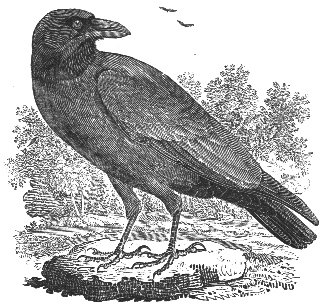

Crow History
1. Eastern Crow
The cooing
was also given in the air
and on one occasion,
I saw a bird drop
slowly down
with wings tilted up
at an angle of forty-five degrees,
singing as he fell.
*
Finally after
many trials
she managed to arrange
a loose array of sticks
in the base
of the fork.
*
I turned back at once
as I had no desire
to disturb the birds'
slumbers but it
was evident
that many,
even at this late hour,
had not settled down
for the night.
2. Western Crow
It was the practise
of the Crows,
after a hot afternoon's work,
to spare themselves the trouble
of flying any considerable
distance to water
by feeding
on watermelons.
*
It is evident
that in such places
ducks could not carry
on nesting
operations
successfully.
*
The flock then rapidly
reacted to the changed
environment by abandoning
attempts at feeding from
the almonds and indeed,
by departing from
the entire region.
3. Northwestern Crow
The old birds
are easy to distinguish
for they sit quietly
in the trees
and gravely watch their young
at play.
*
If the wind is blowing,
they allow for the curve,
and usually do not make
many misses
in their endeavor
to hit a certain boulder.
*
Their most characteristic
one is noted
when the old bird
is feeling especially foolish,
for they duck their heads
toward their feet,
and then give an upward tug,
at the same time
emitting a sound like
the pulling of a cork
from a bottle.
4. Fish Crow
Then away they glide,
from the trees
of the stream banks,
across wide plantations
of truck
gardeners.
*
He adds that they
eat pears,
and are very fond of
ripe figs;
they do considerable damage
to the latter
and have to be driven away
from the fig trees
with a gun.
*
These the Crow
now before us
would frequently seize
with his claws,
as he flew
along the surface,
and retire
to the summit
of a dead tree
to enjoy his repast.
5. Hooded Crow
From the tops
of the pine trees,
they ascended
to a considerable height,
when, hovering for an
instant, they would snap up
an insect and return
to near the former position,
remain for a moment,
and again make an essay.
*
When the observer
rushed up
from a distance
of about 400 yards
both eyes of the
unfortunate animal
had been pecked out
and it was dying,
apparently from injuries
inflicted on the brain
through the
eye sockets.
*
Critical observers
have not generally
considered that they
exercise any
intelligent selection
of hard as opposed
to softer surfaces
for this purpose;
nevertheless there is
evidence that in some
places they have learned
to utilize masonry
or walls
for their
operations.